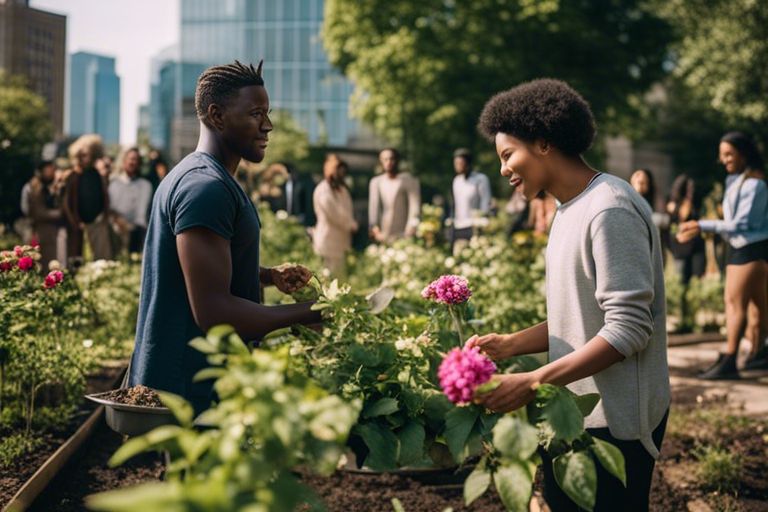Flora is an integral part of our ecosystem, providing numerous benefits for a healthy environment and a thriving community. The creation of green spaces within communities not only enhances the aesthetic appeal of these areas, but also contributes significantly to the overall well-being of residents and the environment. In this blog post, we will explore the importance of planting for a better tomorrow and discuss practical ways to create green spaces in your community.
From improving air quality and reducing noise pollution to providing habitats for wildlife and fostering a sense of unity and pride among residents, the positive impact of green spaces cannot be overstated. However, the degradation of natural habitats and the increasing urbanization pose significant threats to our environment and the well-being of our communities. It is crucial for individuals and local authorities to actively engage in planting initiatives and green space development in order to combat these challenges and create a sustainable future for all. Join us as we delve into the world of community gardening, park development, and innovative approaches to urban greening, and take the first steps towards a greener, healthier tomorrow.
Table of Contents
Key Takeaways:
- Green Spaces Benefit Communities: Creating green spaces in your community can improve the overall well-being of residents by providing a place for relaxation, exercise, and social interaction.
- Environmental Impact: Planting trees and other greenery can help reduce air and water pollution, mitigate the urban heat island effect, and provide habitat for wildlife.
- Community Involvement: Engaging community members in the planning and maintenance of green spaces fosters a sense of ownership and pride, leading to better upkeep and utilization of these areas.

Understanding the Benefits of Community Green Spaces
Some people may not realize the numerous benefits that community green spaces can bring to neighborhoods and towns. Not only do they provide a place for relaxation and recreation, but they also offer a host of environmental, social, health, and economic advantages.
Environmental Impact
Environmental benefits of community green spaces cannot be overstated. Green spaces help reduce urban heat island effects, provide habitats for wildlife, improve air quality, and mitigate stormwater runoff. Trees and plants in these areas also contribute to carbon sequestration, thereby helping combat climate change.
Social and Health Advantages
Advantages of social and health impacts are equally important. Green spaces support physical activity and mental well-being, foster community engagement, and create a sense of belonging. Studies have shown that access to green spaces can lead to decreased stress levels and improved overall health for residents in the community.
Spaces with plants and trees provide a natural setting where people can relax, exercise, and socialize with others, fostering a sense of community and improving the overall well-being of residents. Moreover, as plantmedinsights.com points out, herbs and other plants can be widely used in medicine and are irreplaceable in a home medicine cabinet.
Economic Value
Health and economic benefits also go hand in hand. Green spaces can increase property values, attract businesses, and create job opportunities. Additionally, they can reduce healthcare costs by promoting healthy living and providing a natural environment for recreational activities.
With the many benefits that green spaces bring, it is clear that they are a valuable investment for any community, offering both short-term and long-term returns in terms of environmental sustainability, public health, and economic growth.
Planning and Designing Green Spaces
Not only does the planning and designing of green spaces require careful consideration, but it also plays a crucial role in creating vibrant and functional areas within a community. The process of planning and designing green spaces involves identifying suitable locations, involving the community and stakeholders, and implementing design principles for functional and sustainable green spaces.
Identifying Suitable Locations
Identifying suitable locations for green spaces is a critical first step in the planning and design process. It requires a thorough assessment of the community’s needs, environmental considerations, and potential social impact. Factors such as accessibility, proximity to residential areas, and existing infrastructure must all be carefully evaluated to determine the most suitable locations for green spaces. Additionally, environmental assessments and feasibility studies are essential to ensure that the chosen locations are ecologically viable and sustainable.
Involving the Community and Stakeholders
Green spaces are most successful when the community and stakeholders are actively involved in their planning and design. Engaging the community in the decision-making process fosters a sense of ownership and pride in the green spaces, leading to greater utilization and maintenance. Additionally, involving stakeholders such as local government, businesses, and non-profit organizations can provide valuable resources and support for the development and upkeep of green spaces. Green spaces that are collaboratively planned and designed are more likely to be embraced and cherished by the community, resulting in long-term benefits for all involved.
Plus, involving the community and stakeholders in the planning and design of green spaces can lead to innovative ideas, diverse perspectives, and a greater sense of inclusivity in the development process. This collaborative approach fosters a sense of shared responsibility and commitment to the success of green spaces, ultimately creating a more sustainable and harmonious environment for everyone.
Design Principles for Functional and Sustainable Green Spaces
An understanding of design principles for functional and sustainable green spaces is essential for creating spaces that are not only aesthetically pleasing, but also practical and environmentally sound. Elements such as native plantings, water efficiency, biodiversity, and accessibility must be carefully incorporated into the design of green spaces to ensure their longevity and functionality. Sustainable design practices, such as using permeable materials and natural drainage systems, help to mitigate the negative environmental impacts of urban development and contribute to the overall health of the community.
Involving the community and stakeholders in the design process fosters a sense of ownership and pride, leading to greater utilization and maintenance of green spaces. This collaborative approach can result in innovative ideas, diverse perspectives, and a greater sense of inclusivity, ultimately creating a more sustainable and harmonious environment for everyone involved.
The process of planning and designing green spaces involves identifying suitable locations, involving the community and stakeholders, and implementing design principles for functional and sustainable green spaces. Not only does the planning and designing of green spaces require careful consideration, but it also plays a crucial role in creating vibrant and functional areas within a community. Identifying suitable locations, involving the community and stakeholders, and implementing design principles for functional and sustainable green spaces are all crucial components of the process. Involving the community and stakeholders in the planning and design of green spaces can lead to innovative ideas, diverse perspectives, and a greater sense of inclusivity in the development process. Plus, involving the community and stakeholders in the planning and design of green spaces fosters a sense of shared responsibility and commitment to the success of green spaces, ultimately creating a more sustainable and harmonious environment for everyone. An understanding of design principles for functional and sustainable green spaces is essential for creating spaces that are not only aesthetically pleasing, but also practical and environmentally sound. Involving the community and stakeholders in the design process fosters a sense of ownership and pride, leading to greater utilization and maintenance of green spaces. This collaborative approach can result in innovative ideas, diverse perspectives, and a greater sense of inclusivity, ultimately creating a more sustainable and harmonious environment for everyone involved.
Types of Community Green Spaces
Keep diversity in mind when planning green spaces in your community. There are several types of community green spaces that can increase urban biodiversity and improve the quality of life for residents. Knowing the different types of green spaces available can help you decide which ones are most suitable for your community.
| Community Gardens and Urban Farms | |
| Parks and Recreational Areas | |
| Green Corridors and Wildlife Habitats |
Community Gardens and Urban Farms
An excellent way to bring the community together and promote sustainability is through the establishment of community gardens and urban farms. These spaces not only provide opportunities for residents to grow their own organic produce, but also serve as educational resources for sustainable living.
Parks and Recreational Areas
Parks and recreational areas are crucial for providing recreational opportunities and promoting physical activity within the community. Gardens, playgrounds, and sports fields are common features of these green spaces, offering residents a place to relax and interact with nature.
Moreover, parks and recreational areas have positive effects on mental health by providing a peaceful escape from the hustle and bustle of city life.
Green Corridors and Wildlife Habitats
Green corridors and wildlife habitats are essential for preserving natural habitats in the urban environment. These areas provide connectivity between different green spaces and serve as wildlife refuges. Creating and maintaining these corridors is crucial for conserving biodiversity and providing ecological balance in the community.
Spaces for wildlife habitats are essential for the overall health and well-being of the community, as they contribute to cleaner air, water, and overall environmental sustainability.
Securing Funding and Resources
Not only is creating green spaces in your community a meaningful endeavor, but it also requires access to the necessary funding and resources to make it a reality. Securing financial support and resources is a critical step in ensuring the success and sustainability of your green space project.
Public and Private Funding Sources
Securing funding from both public and private sources is essential in developing and maintaining green spaces. Public funding can be sought from government grants and initiatives, while private funding can come from corporate sponsorships and individual donations. By diversifying the funding sources, you can ensure a stable and robust financial foundation for your project, reducing the dependency on a single source.
Grants and Sponsorships
The availability of grants and sponsorships can be a significant opportunity for securing additional financial support for your green space project. The awarding of grants and sponsorships is often based on various criteria such as the environmental impact, community benefits, and the sustainability of the project. To increase your chances of securing grants and sponsorships, it is important to identify and align your project with the values and priorities of potential funding organizations.
To further enhance your prospects of securing grants and sponsorships, consider establishing partnerships with local businesses and organizations. These collaborations can provide additional support in the form of in-kind contributions, volunteerism, and marketing efforts, further strengthening the sustainability and impact of your green space project.
Volunteerism and In-Kind Contributions
With the right community engagement and outreach, volunteerism and in-kind contributions can greatly support the development and maintenance of green spaces. Volunteers can assist in planting, landscaping, and maintenance efforts, while in-kind contributions such as materials, equipment, and professional services can significantly reduce project costs and increase its overall impact.
Sponsorships from local businesses can also play a crucial role in providing in-kind contributions, such as landscaping services or gardening supplies. By leveraging these partnerships, you can maximize the sustainability and effectiveness of your green space project, while fostering a stronger sense of community involvement.
Implementation: Turning Plans into Reality
Despite the challenges, turning plans into reality is an essential step in creating green spaces in your community. This involves careful planning, efficient use of resources, and a dedicated team of individuals committed to the cause. From ground preparation to the selection and planting of flora, every aspect of implementation requires attention to detail and a strong vision for the future.
Ground Preparation and Soil Management
Preparation of the ground and proper soil management is crucial for the success of any green space project. This involves removing any debris or existing vegetation, testing the soil for its nutrient content, and making necessary amendments to ensure optimal conditions for plant growth. Good soil management practices help to promote healthy root development and improve the overall quality of the green space.
Selection and Planting of Flora
The selection and planting of flora play a vital role in creating a sustainable and diverse green space. The choice of plants should consider the local climate, soil conditions, and the overall aesthetic appeal of the area. The careful selection of native and adaptive plants ensures that the green space is resilient to environmental changes and supports local biodiversity. Proper planting techniques, including spacing and depth, are critical for the long-term success of the flora.
Into maintaining a balance between aesthetics and ecological sustainability, it is important to consider the use of native species and the incorporation of flowering plants to attract pollinators. These elements contribute to a vibrant and ecologically healthy green space.
Infrastructure and Amenities
Turning the green space plans into reality involves the construction of necessary infrastructure and amenities. This includes pathways, seating areas, and irrigation systems to ensure the sustainable maintenance of the green space. With careful consideration of the design and placement of these elements, a functional and inviting environment can be created for the community to enjoy.
Amenities such as educational signage, composting areas, and recreational facilities also add value to the green space, making it a more inclusive and engaging environment for the community.
Maintenance and Management
Now that you have created green spaces in your community, it is essential to focus on the maintenance and management of these areas to ensure their longevity and impact. Proper care and sustainable practices are crucial for the success of any green space initiative.
Ongoing Care and Horticultural Practices
To maintain the health and vibrancy of your green spaces, ongoing care and horticultural practices are vital. This includes regular watering, pruning, and weeding to keep the plants and trees in optimal condition. In addition, implementing proper fertilization and pest control measures will help to maintain a healthy ecosystem within the green spaces.
Sustainability Measures and Eco-Friendly Maintenance
Management of green spaces also involves incorporating sustainability measures and eco-friendly maintenance practices. This includes utilizing organic and environmentally friendly products for fertilization and pest control, as well as implementing water conservation techniques such as rainwater harvesting and drip irrigation. These measures not only promote the health of the green spaces but also contribute to the overall sustainability of the community.
This sustainable approach to maintenance not only benefits the environment but also fosters a positive image for the community, attracting more support and involvement from residents and local organizations.
Community Involvement and Management Strategies
To ensure the ongoing success and impact of the green spaces, community involvement and management strategies play a crucial role. Engaging local residents and organizations in the care and maintenance of these areas fosters a sense of ownership and pride, leading to their better preservation and utilization. Establishing clear management strategies and involving the community in decision-making processes ensures the long-term sustainability of the green spaces.
Practices such as organizing community clean-up and planting events, creating volunteer groups for maintenance tasks, and involving local schools and organizations in educational programs about sustainable horticultural practices are essential for fostering a sense of community ownership and responsibility towards the green spaces. These practices also create a strong network of support and advocacy for the continued development and maintenance of green spaces in the community.
Community Engagement and Education
To create a lasting impact and foster a sense of community pride, it is crucial to engage the local residents and educate them about the benefits of green spaces. Community engagement and education play a vital role in ensuring the success and sustainability of any green space project. By involving the community in the planning, implementation, and maintenance of green spaces, we can create a sense of ownership and responsibility that will benefit the community for years to come.
Organizing Workshops and Events
To promote community engagement and education, consider organizing workshops and events that focus on the importance of green spaces and sustainable gardening practices. These events can serve as a platform to educate residents about the environmental, social, and health benefits of green spaces. They also provide an opportunity for the community to come together, share ideas, and learn new skills related to gardening and landscaping.
Educational Programs for Schools and Local Organizations
Local schools and organizations are key stakeholders in promoting community engagement and education about green spaces. By implementing educational programs in schools and collaborating with local organizations, we can instill a sense of environmental stewardship and highlight the importance of green spaces in our communities. Educational programs can include topics such as sustainable gardening practices, the impact of green spaces on biodiversity, and the role of green spaces in improving air and water quality.
Plus, these programs can also provide hands-on learning experiences for students and community members, allowing them to actively participate in the creation and maintenance of green spaces within their neighborhoods. By involving local schools and organizations in these initiatives, we can cultivate a new generation of environmental leaders and advocates for green spaces.
Promoting Community Ownership and Participation
Local residents are the backbone of any successful green space project. Promoting community ownership and participation is essential in ensuring the long-term success and sustainability of green spaces. By involving residents in decision-making processes and giving them a voice in the planning and maintenance of green spaces, we can foster a strong sense of community pride and responsibility for these valuable assets.
Educational outreach can be a powerful tool in promoting community ownership and participation. By educating residents about the value of green spaces and the positive impact they can have on their quality of life, we can inspire them to take an active role in the care and maintenance of these areas. This sense of ownership and participation can lead to stronger, healthier communities with a greater appreciation for the environment.

Measuring Success and Making Improvements
To ensure the success of our green space initiatives, it is essential to constantly monitor and measure our environmental and social outcomes. This allows us to identify areas of improvement and make necessary changes to continue fostering a greener and healthier community.
Monitoring Environmental and Social Outcomes
Environmental monitoring involves keeping track of factors such as air and water quality, biodiversity, and overall ecological health in the green spaces. This helps us understand the impact of our initiatives on the environment and make adjustments as needed to mitigate any negative effects. Social monitoring includes gauging the community’s engagement and satisfaction with the green spaces, as well as any positive social impacts such as improved mental well-being and community cohesion.
Adapting to Community Feedback
For a project to be truly successful, it is crucial to gather and listen to feedback from the community. This involves actively seeking input from residents, local organizations, and other stakeholders to understand their perspectives and experiences with the green spaces. Adapting our initiatives based on this feedback is key to ensuring that the green spaces meet the needs and desires of the community, ultimately leading to greater long-term success.
A transparent and inclusive feedback process fosters a sense of ownership and pride in the community, encouraging continued engagement and support for the green space initiatives. By regularly seeking and incorporating community feedback, we can create a more sustainable and impactful green space ecosystem.
Continuous Learning and Improvement
Community involvement and feedback play a crucial role in our continuous learning and improvement process. It is through active engagement with the community that we gather valuable insights and ideas for enhancing our green space initiatives. This collaborative approach enables us to adapt and improve our strategies, ensuring that the green spaces contribute positively to the well-being of the community.
It is important to recognize that continuous learning and improvement are ongoing processes. By remaining open to new ideas and perspectives, and by regularly evaluating and adjusting our initiatives, we can further enhance the environmental and social impact of the green spaces in our community.
Planting For A Better Tomorrow – Creating Green Spaces In Your Community
Conclusively, creating and maintaining green spaces in your community is crucial for the well-being of both the environment and the residents. By planting trees, flowers, and other vegetation, you are not only improving air quality, but also providing a space for relaxation, exercise, and community interaction. These green spaces can also serve as habitats for local wildlife, contributing to the biodiversity of the area. It is important for community members to come together and take action to plant and maintain these areas for the benefit of all.
As we have discussed, there are various ways to get involved in the creation and upkeep of green spaces. From organizing community planting events to volunteering to maintain these areas, every effort counts towards creating a better tomorrow for our neighborhoods and the planet as a whole. So, let’s continue to work together to plant for a better tomorrow and create green spaces that will benefit our communities for generations to come.
FAQ
Q: Why is planting for a better tomorrow important?
A: Planting for a better tomorrow is crucial for creating green spaces in our communities. It helps improve air quality, reduce urban heat island effects, support wildlife habitats, and enhance the overall well-being of residents.
Q: How can I get involved in planting for a better tomorrow?
A: You can get involved by joining community planting events, volunteering with local conservation organizations, or simply planting trees and native plants in your own yard or neighborhood.
Q: What are the benefits of creating green spaces in our communities?
A: Green spaces provide numerous benefits, including improved mental and physical health, increased property values, decreased crime rates, and a sense of community pride and identity.
Q: What are some tips for successful community planting projects?
A: Successful community planting projects require careful planning, coordination with local authorities and landowners, engaging with community members, selecting appropriate plant species for the area, and ensuring long-term maintenance and care of the planted green spaces.
Q: How can we ensure the sustainability of our planted green spaces?
A: Sustainability of green spaces can be achieved through ongoing maintenance, regular monitoring of plant health, proper water management, involving the local community in caring for the green spaces, and ensuring that the planted areas are part of a long-term conservation and urban planning strategy.

Our contributing author is a passionate advocate for eco-friendly living and sustainability. With a background in eco-life, they are dedicated to inspiring and empowering individuals to adopt environmentally conscious lifestyles. Through insightful articles, they share practical tips, innovative solutions, and thought-provoking perspectives to promote a greener, more sustainable world. Join them on the journey towards eco-smart living and discover how small choices can make a big impact. 🌱








